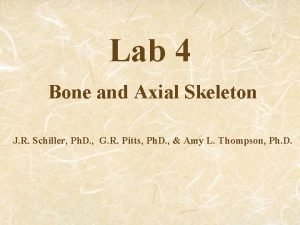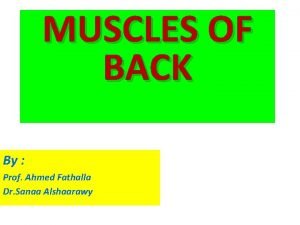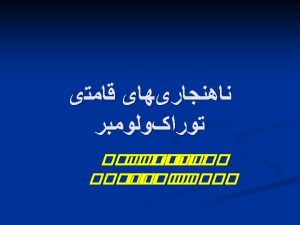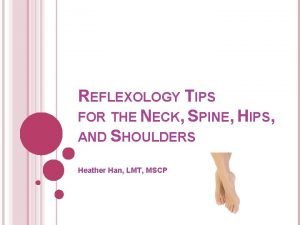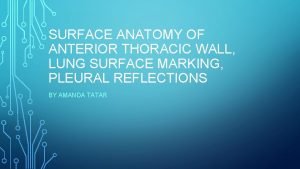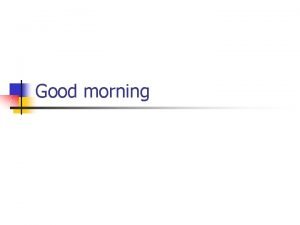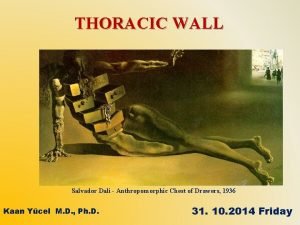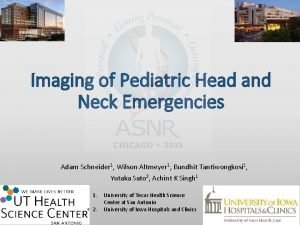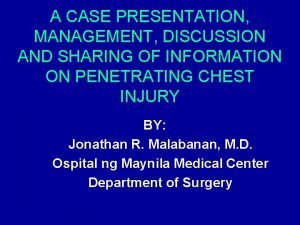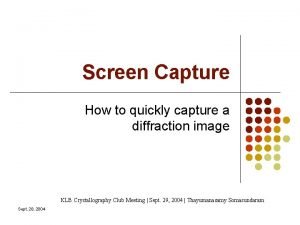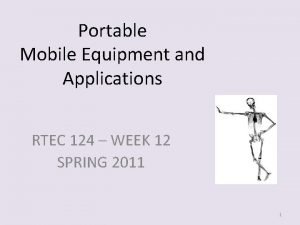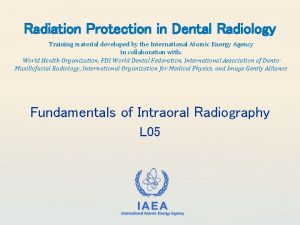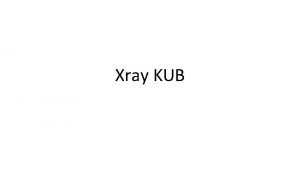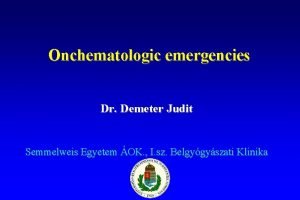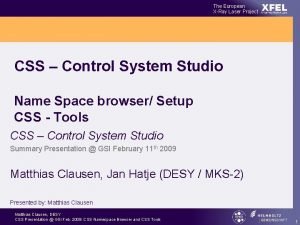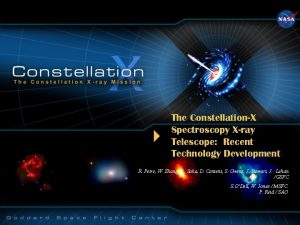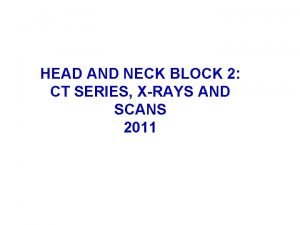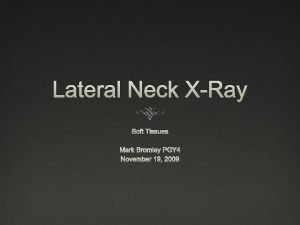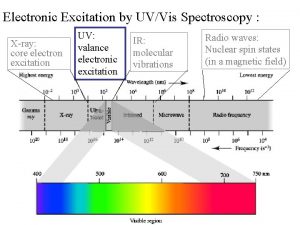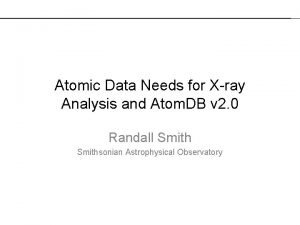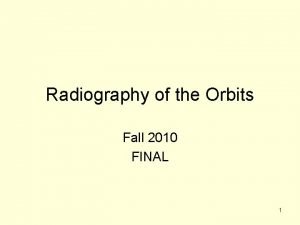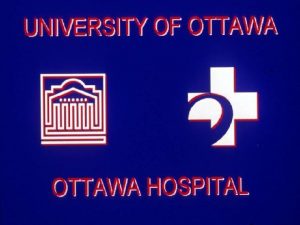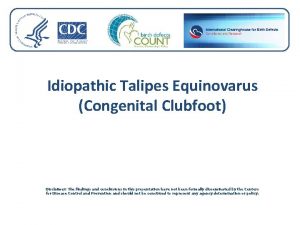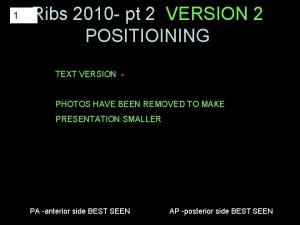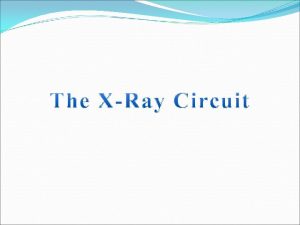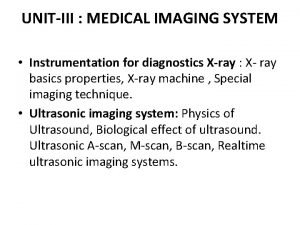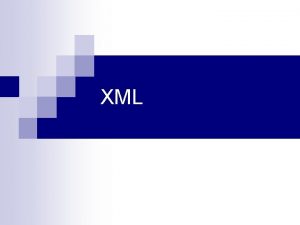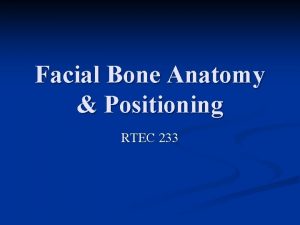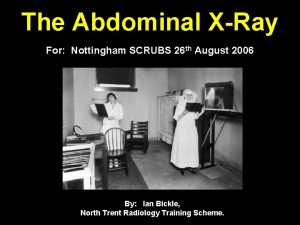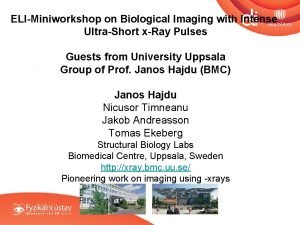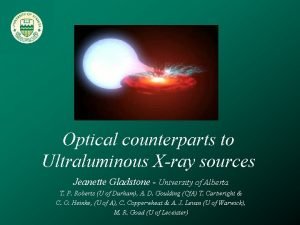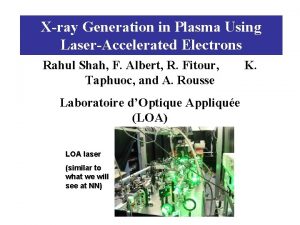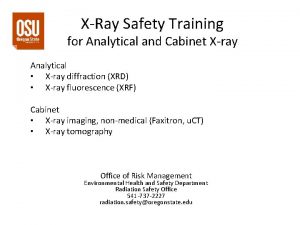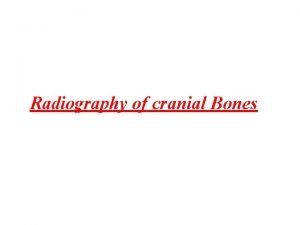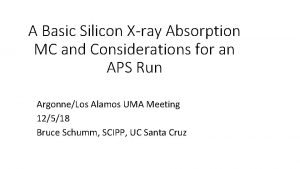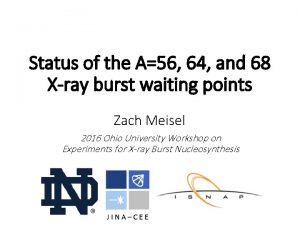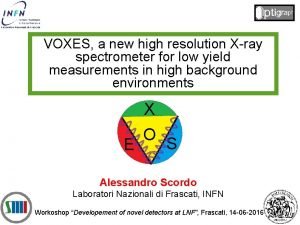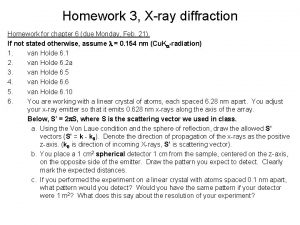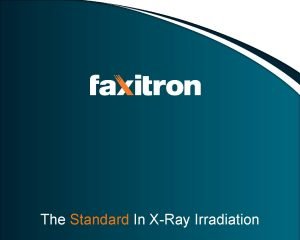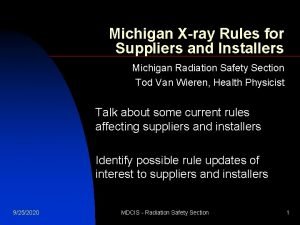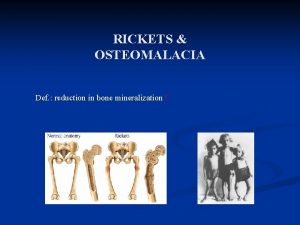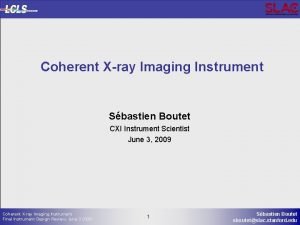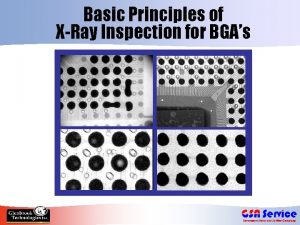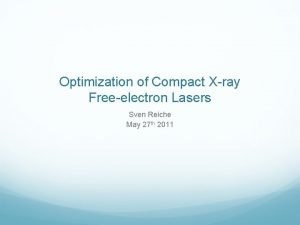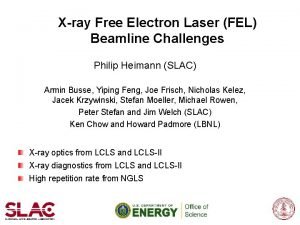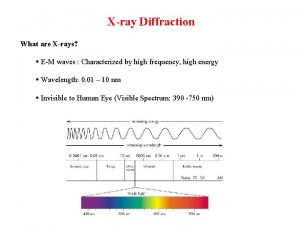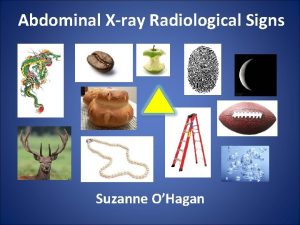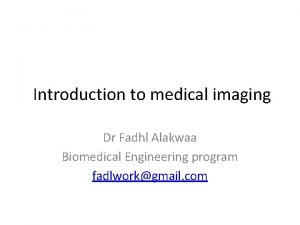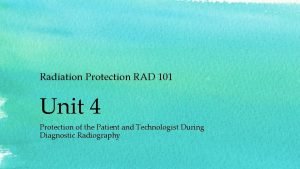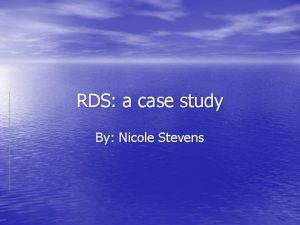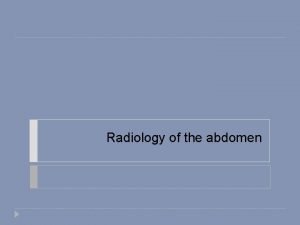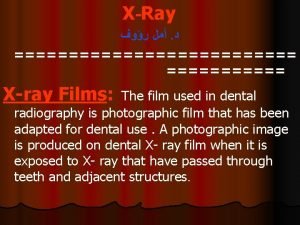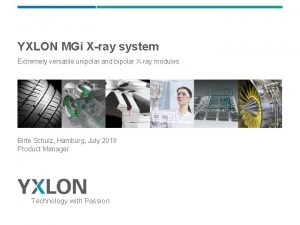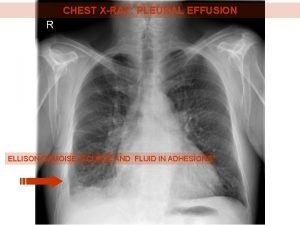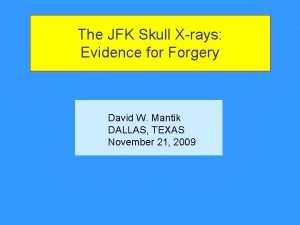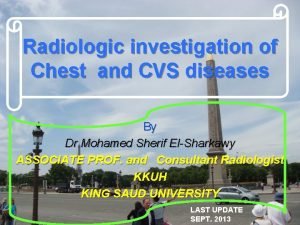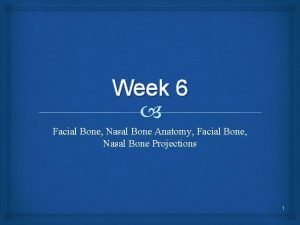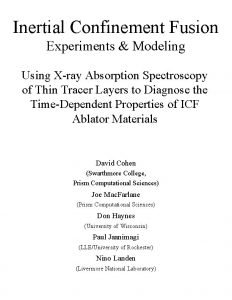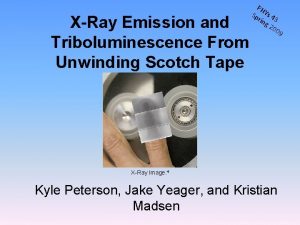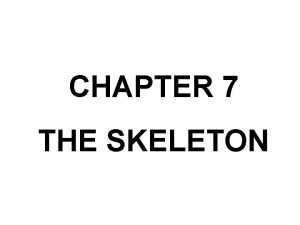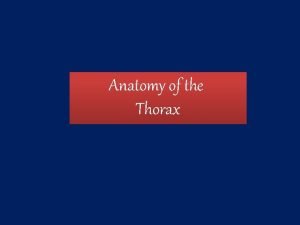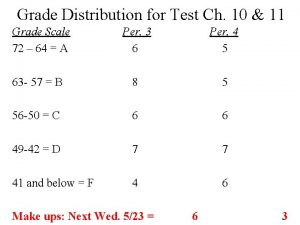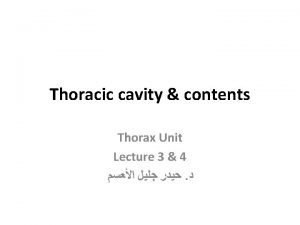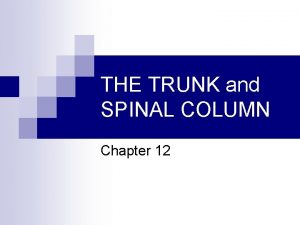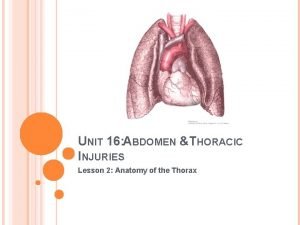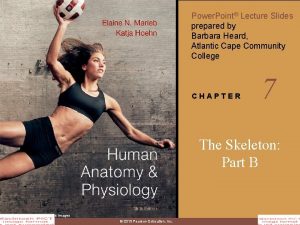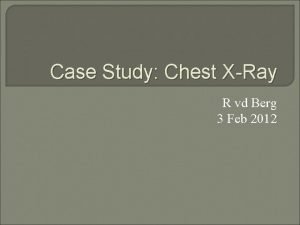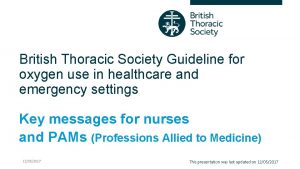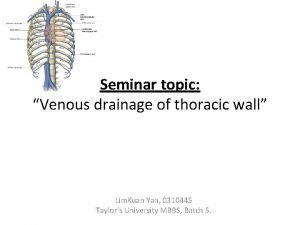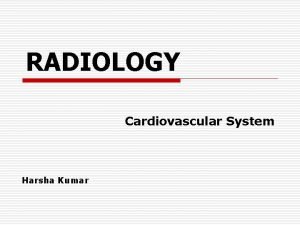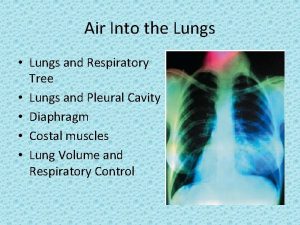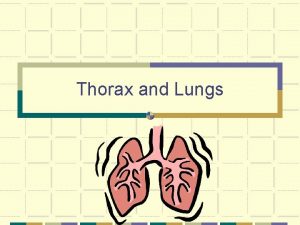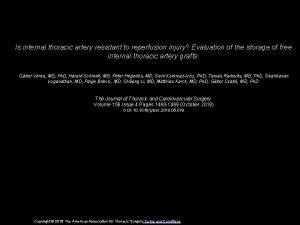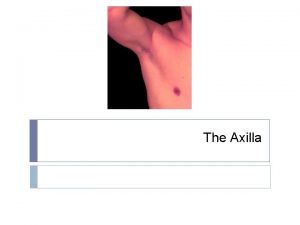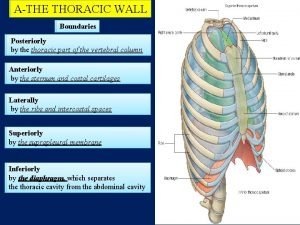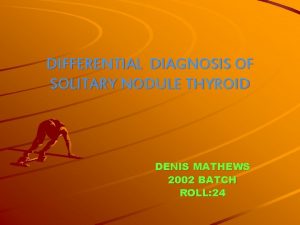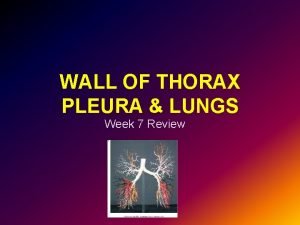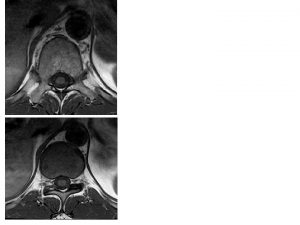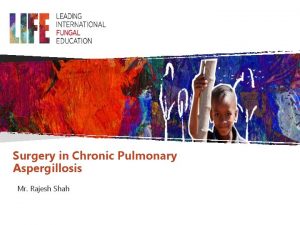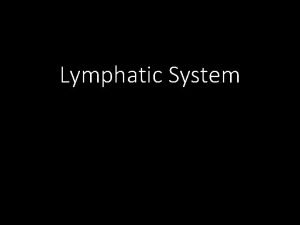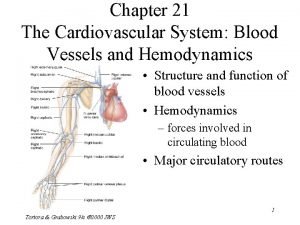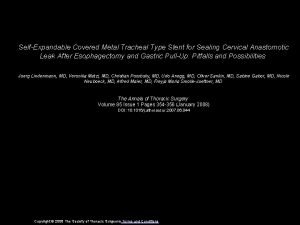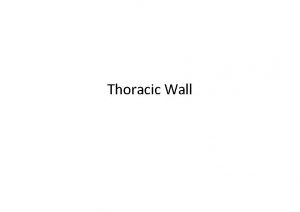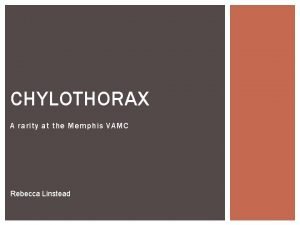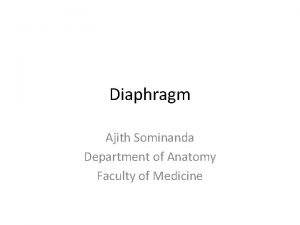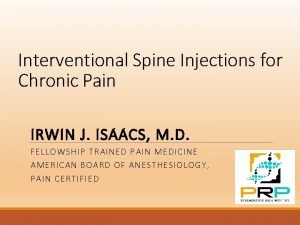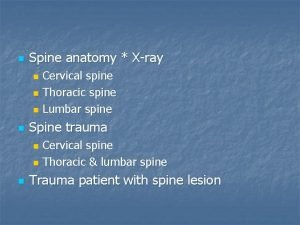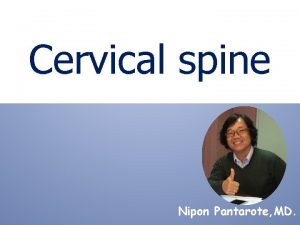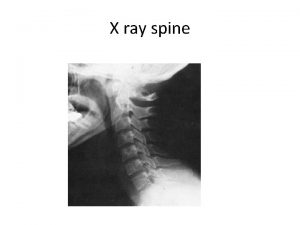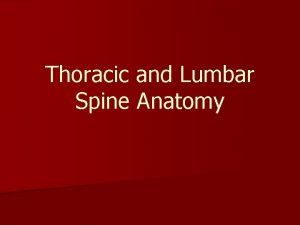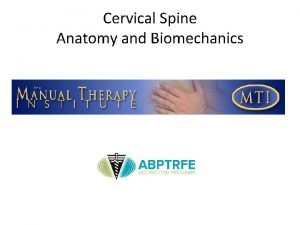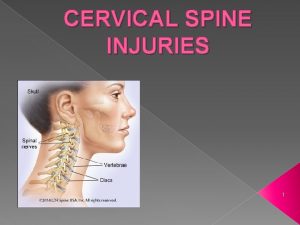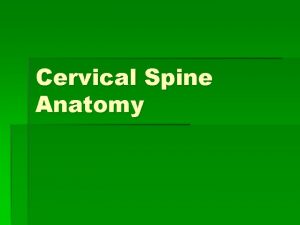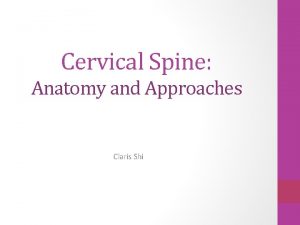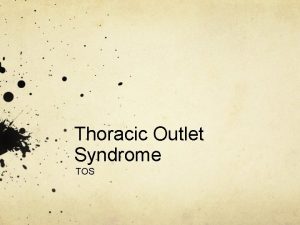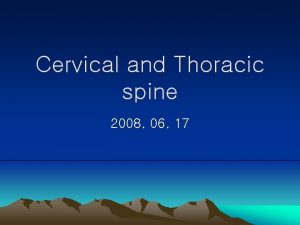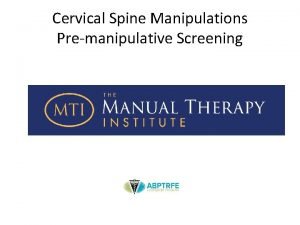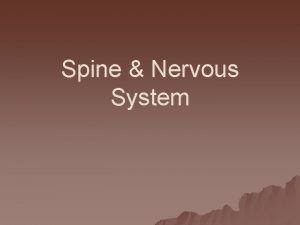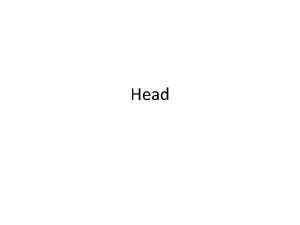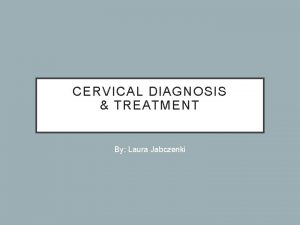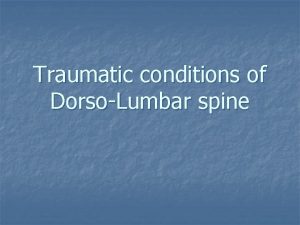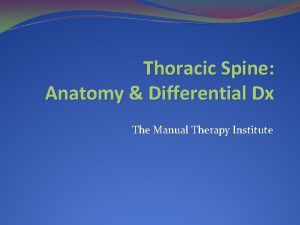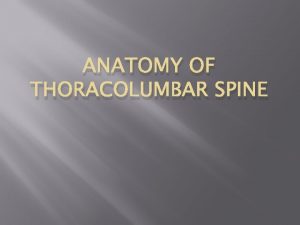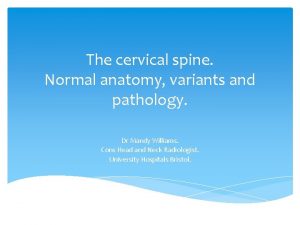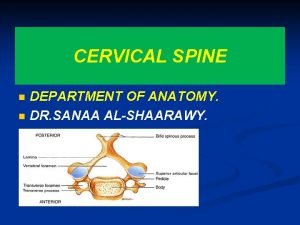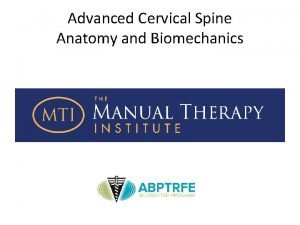n Spine anatomy Xray Cervical spine n Thoracic

























































































































- Slides: 121

n Spine anatomy * X-ray Cervical spine n Thoracic spine n Lumbar spine n n Spine trauma Cervical spine n Thoracic & lumbar spine n n Trauma patient with spine lesion

Cervical spine

Spine Anatomy

Anatomy

Anatomy

Anatomy

Anatomy

Anatomy

Anatomy 3 2 1 4

Cervical spine X-ray

C spine X-ray Lateral view 5 4 6 1

C spine X-ray Lateral view

C spine X-ray Lateral view

C spine X-ray Lateral view

C spine X-ray Lateral view

C spine X-ray AP view 2 1

C spine X-ray AP view

C spine X-ray AP view

C spine X-ray Oblique view

C spine X-ray Oblique view

C spine X-ray Oblique view

C spine X-ray OMO view 1 2 2 3

C spine X-ray OMO view

Thoracic spine

Spine Anatomy

Anatomy

Normal kyphosis 15° - 50°

Anatomy

Anatomy

T spine X-ray

T spine X-ray AP view 1 2 3

T spine X-ray AP view

T spine X-ray lateral view

T spine X-ray lateral view

Lumbar spine

Spine Anatomy

Anatomy

Normal lordosis < 60° slop of sacral base = 45° from horizon

L spine X-ray

L spine X-ray AP view

L spine X-ray AP view

L spine X-ray AP view

L spine X-ray AP view 1 4 2 3

L spine X-ray Lateral view

L spine X-ray Lateral view


L spine X-ray Oblique view Scotty dog sign 3 1 2 4 5 6

L spine X-ray Oblique view Scotty dog

L spine X-ray Oblique view

L spine X-ray Oblique view


C spine trauma

Denis’ three column model of the spine

The stability n n n Anterior column injury → stable Anterior & middle column injury→more unstable 3 column injury → unstable


C 2 tear drop fracture stable

Hangman fracture Unstable

Wedge fracture Unstable

Tear drop fracture

C 5 -C 6 Bilateral facet dislocation

C 4 -C 5 Bilateral facet dislocation Unstable

Unlateral facet dislocation Unstable

C 5 C 6 bilateral facet subluxation Unstable

Atlantodental interval Atlanto-axial instability Unstable

Occipitoatlantal articulation Power ratio

T+ L spine trauma

90 % of spine fractures

Effects on spine‘s functions 1. 2. 3. 4. Stability Posture Neural protection Neurological function

Denis’ three column model of the spine

1 - Stability More columns damage → more instability

2 - Posture and deformity

2 - Posture and deformity n n n Pain Imbalance at the fracture site Compensatory curves

3 - Neural protection Spinal deformity ↓ spinal canal stenosis ↓ Varying degree of compression

Neural structures occupies 50% spinal canal volume

4 - neural function n n Nerve lesion Cord lesion

Nerve lesion (Overstretched–crushed–severed) nerve structures ↓ Irreversible Chance for recovery : Partial lesion n Release within 8 hours n

Cord lesion Drug may give a chance MPS ( corticosteroid ) Reduce necrosis / oedema n In the first 8 hours n n Regimen : 30 mg/kg/15 minutes After 45 minute 5. 4 mg/kg/hour for 23 hour

Lesion classification

T vertebra Burst fracture

L 2 burst fracture

L 3 burst fracture with rotation

2 T 8 burst fracture + T 9 wedge fracture 8

Trauma patient with spine lesion

Causes of spinal column and spinal cord injury

Trauma patient n n The A – B – C – D RESUSCITATION ( BP ) Conscious level ( Glasgow coma scale ) Assessment of injuries ( Determine the PRIORITY )

Trauma patient - accident scene n n n A : airways B : breathing C : circulation & cervical spine D : disability – drugs E : exposure ( undress the patient ) Spinal column injury must be suspected in in all polytrauma patients, especially < intoxicated – unconscious > individuals.

Trauma patient - Transfer Scoop-style stretcher

Trauma patient Transfer

Trauma patient - Resuscitation Blood pressure BP > 85 mm Hg → better neurogenic outcome

Neurogenic shock n 3 vital signs indicates above T 6 injury : Hypotension n Hypothermia n Bradycardia n Disruption of sympathetic outflow. T 1 -L 2 ↓ unopposed vagal tone

Low blood pressure. . !? ↓ BP + bradycardia =Neurogenic shock ↓ BP + tachycardia = blood loss occult intra-abdominal injuries

Trauma patient - Resuscitation How to deal with Neurogenic shock : n volume replacement n vasopressors And of course<Treat other injuries>

Trauma patient - Assessment Physical examination : n Head n n n n lacerations Contusions Facial fractures ear canal - nasal leakage ( CSF – blood ) Spinous processes palpation Bowel / bladder incontinence Penile erection Occult injury ( abdomen – chest – extremities )

Neurologic evaluation n Level of conscious : n Glasgow coma scale Eyes open n Best verbal response n Best movement response n

Sensory examination

the nipple line (T 4) xiphoid process (T 7) umbilicus (T 10) Dermatomes inguinal region (T 12, L 1) The perineum and perianal region (S 2, S 3, S 4)

Motor examination

Motor examination

Reflexes Stretch reflexes: n Spinal shock = absent n Upper motor neuron lesion = hyperreflexia + spasticity + clonus n Lower motor neuron lesion = absent

Reflexes n Planter reflex : Babinski’s sign n Oppenheim’s sign n n Cremasteric reflex T 12 -L 1

Lesion level The most caudal segment with both sensory and motor function bilaterally

Complete / incomplete cord lesion? n n Complete : no motor/sensory function exist more than 3 segments below the site of injury. Incomplete : some neurologic function below it.

Just to remember !

Classification Central cord syn. Anterior cord syn. Posterior cord syn. Brown-Sequal syn.

Sacral sparing Continued function in the conus medularis = incomplete cord injury Assessment : n Perianal sensation n Toe flexion n Rectal sphincter

Spinal shock n n n After severe spinal cord injury A state of complete spinal Areflexia. Last for varying length of time. 99% within 24 hour. n Evaluation by : Testing the bulbocavernosus reflex ( S 3 – S 4 ) n Anal wink reflex n

Bulbocavernosus reflex Anal wink

Spinal shock n After injury : n No evidence of spinal function below the level of injury ( even bulbocavernosus reflex ) → no determination of completeness of injury n Return of bulbocavernosus reflex with no sacral sparing signs → complete lesion

Roentgenogram n Plain Xray : Routinely n Chest n Pelvis n Cervical spine <AP/Lateral> Poly trauma n <AP/Lateral> thoraco-lumbar spine film n n CT MRI

ER intervention n High dose intravenous methylprednisolone Within 8 hours = more significant improvement 30 mg/kg in 15 minutes → after 45 minutes → 5. 4 mg/kg/hr in the remained 23 hour Complications : Wound infection GI Haemorrhage

ER intervention n Osmotic diuretics Manitol n Low molecular weight dextran n Used in head trauma No clinical effectiveness in spinal cord injury

ER intervention n Cervical stabilization : Bilateral sand bag + taping n Philadelphia collar n Traction : n Gardner wells n Halo vest n

Taping

Philadelphia collar

Gardner-wells tongs

Halo vest orthosis

Thoraco-lumbar braces n n Jewett brace Custom-molded TLSO

Jewett brace

Full contact braces


 Difference between cervical thoracic and lumbar vertebrae
Difference between cervical thoracic and lumbar vertebrae Muscles of thoracic spine
Muscles of thoracic spine Flat thoracic spine
Flat thoracic spine Auscultatory triangle of the back
Auscultatory triangle of the back Spine reflexology
Spine reflexology Surface anatomy of thoracic wall
Surface anatomy of thoracic wall External intercostal muscles
External intercostal muscles Umbliculus
Umbliculus Steeple sign
Steeple sign Noi toi poi doi meaning
Noi toi poi doi meaning Gimp xray
Gimp xray Capacitor discharge mobile x-ray units
Capacitor discharge mobile x-ray units Common causes of faulty radiographs
Common causes of faulty radiographs Who discovered x rays
Who discovered x rays Plain film kub
Plain film kub Supine chest xray
Supine chest xray Xray laser
Xray laser Xray telescope
Xray telescope Pterigoid plate
Pterigoid plate Xray searches
Xray searches Aryepiglotic
Aryepiglotic Spectrum xray
Spectrum xray Atom xray
Atom xray Pink tof vs blue tof
Pink tof vs blue tof Sphenoid strut
Sphenoid strut Peter mueller mit
Peter mueller mit Zenker's diverticulum xray
Zenker's diverticulum xray Xray laser
Xray laser Clubfoot clinical features
Clubfoot clinical features Lpo ribs
Lpo ribs What are the two areas in dark room? *
What are the two areas in dark room? * Uranus xray
Uranus xray High frequency generator x ray
High frequency generator x ray Properties of x rays
Properties of x rays Xray xml editor
Xray xml editor Reverse waters
Reverse waters X ray scrubs
X ray scrubs Xray laser
Xray laser Xray gladstone
Xray gladstone Xray laser
Xray laser Xray training
Xray training Tetralogy of fallot xray
Tetralogy of fallot xray Gladstone park xray
Gladstone park xray Occipito-frontal
Occipito-frontal Silicon valley xray
Silicon valley xray 68 xray
68 xray X ray mastoid towns view
X ray mastoid towns view Xray spectrometer
Xray spectrometer Hampton hump sign คือ
Hampton hump sign คือ Patterson
Patterson Xray file cabinet
Xray file cabinet Mdcis
Mdcis Lara xray
Lara xray Sza xray
Sza xray Rickets xray
Rickets xray Picker xray
Picker xray Bga xray
Bga xray Xray laser
Xray laser Xray lithography
Xray lithography Xray laser
Xray laser Xray waves examples
Xray waves examples Gegasx
Gegasx Fadhl alakwaa
Fadhl alakwaa Xray technique chart
Xray technique chart Xray photoelectron spectroscopy
Xray photoelectron spectroscopy Pnuemothorax xray
Pnuemothorax xray Rigler sign
Rigler sign The purpose of a lead foil sheet in the film packet is
The purpose of a lead foil sheet in the film packet is Xray laser
Xray laser Prehistoric era
Prehistoric era Unipolar generator
Unipolar generator Mmc xray
Mmc xray Foreshortening and elongation
Foreshortening and elongation Pleural effusion ellis curve
Pleural effusion ellis curve Jfk skull
Jfk skull Hypoinspiratory
Hypoinspiratory Reverse waters method
Reverse waters method Xray laser
Xray laser Inertia xray
Inertia xray Triboluminescence scotch tape
Triboluminescence scotch tape Thoracic cage anterior view
Thoracic cage anterior view Thoracic outlet wedge pillow
Thoracic outlet wedge pillow Layers of chest wall
Layers of chest wall Thoracic kyphoscoliosis definition
Thoracic kyphoscoliosis definition Pig thoracic cavity diagram
Pig thoracic cavity diagram Sibson's fascia
Sibson's fascia Which ventral cavity subdivision has no bony protection
Which ventral cavity subdivision has no bony protection Thorasic extension
Thorasic extension Thoracic cavity
Thoracic cavity Rib tubercle
Rib tubercle Thoracic aortic aneurysm
Thoracic aortic aneurysm O2 flow rate chart
O2 flow rate chart Portal and caval venous system
Portal and caval venous system Atheromatous thoracic aorta
Atheromatous thoracic aorta Volume of thoracic cavity
Volume of thoracic cavity Neurogeen thoracic outlet syndroom
Neurogeen thoracic outlet syndroom Thoracic cage configuration
Thoracic cage configuration Bony chest female
Bony chest female Bean size lymph node
Bean size lymph node Thoracic surgery
Thoracic surgery Posterior
Posterior Lumbodorsal fascia
Lumbodorsal fascia Sternal angle of louis
Sternal angle of louis Thoracic cavity labeled
Thoracic cavity labeled Lungs body cavity
Lungs body cavity Thoracic inlet x ray
Thoracic inlet x ray Jugular notch of sternum
Jugular notch of sternum Arteries of thoracic wall
Arteries of thoracic wall Corpus callosum anatomy radiology
Corpus callosum anatomy radiology Lateral surface of sacrum
Lateral surface of sacrum Rajesh shah thoracic surgeon
Rajesh shah thoracic surgeon Short tube that receives purified lymph
Short tube that receives purified lymph Branches of aorta
Branches of aorta Body cavities labeled
Body cavities labeled Thoracic nerves
Thoracic nerves Thoracic surgeon
Thoracic surgeon Thoracic wall
Thoracic wall Thoracic duct
Thoracic duct Antecubitis
Antecubitis Posterior mediastinum
Posterior mediastinum Ajith sominanda
Ajith sominanda Vertebrae
Vertebrae
